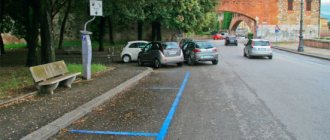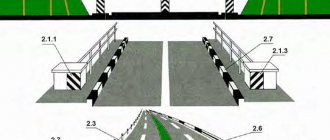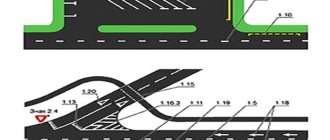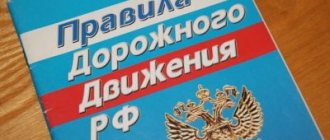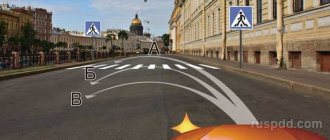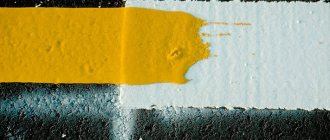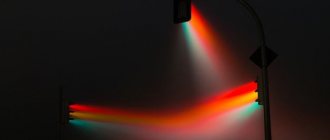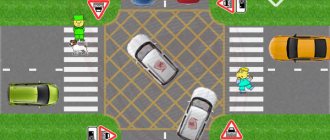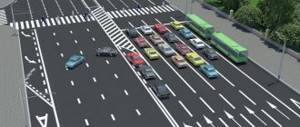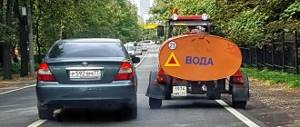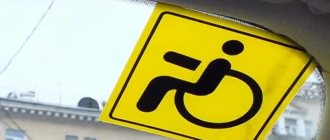Three main colors of road markings: choose the most important one
If you drive a car or often drive it as a passenger, then, of course, you see markings on the roads.
The first category of markings must be monitored in accordance with traffic rules, the second one one way or another becomes an involuntary witness to “standardized creativity” on the roads. see also
We remind you: A new type of marking will be introduced from June 1, 2021
Moreover, as you can see, road markings differ not only in appearance (solid, intermittent, pedestrian crossing, various speed limit signs, “Caution: children!” and so on), but also by color.
And if previously the palette of paints was given to road workers in a rather meager set, then with the coming into force of GOST R 51256-2018 in 2021, the paints sparkled with new colors:
White Yellow Red For temporary road markings, the color is set to orange and even blue green black
Moreover, all six colors, except those designated as temporary orange, are included in the technical requirements for permanent horizontal markings. That is, according to GOST, road workers can use it in a standardized manner in specified cases. True, blue and red are not yet registered in the traffic rules, which means that they will still not be found on the roads, but the rest of the palette - please, is present on the roads!
Multi-colored markings may appear on Russian roads
Previously, GOST provided only three colors for road markings: white for most types of markings, yellow for places where stopping or parking is prohibited, orange for temporary markings.
Now permanent markings, which previously were only white or yellow, can be in other colors: red, blue, green and even black.
The point of such innovations is to separate marking lines that are more important for safety from those that are less important. For example, markings that indicate lanes within an intersection may now be blue. The same color can be used to mark the boundaries of parking spaces.
According to the new GOST, yellow will be used to indicate those zones where overtaking is prohibited.
The new markings on Russian roads, which are regulated by the GOST standard that came into force on June 1, 2021, will be more informative precisely due to the color variety. However, drivers do not have to learn when to use blue markings and when to use green markings. The lines themselves will remain the same, they mean the same as before, so the main thing is the form of the marking.
Why was such a wide variety of colors needed?
Thus, the developers of the new standard made the perception of markings better, they became more visible to drivers - without complicating the rules, duplicating or emphasizing certain road conditions. In congested urban environments, a motorist will be able to quickly navigate the roadway, and for beginners this is generally a storehouse of knowledge.
Signs, coupled with well-applied markings, will be able to present the full picture much faster than a monotonous white composition on the asphalt. The main thing is to remember which color and pattern belongs to what.
Especially taking into account the fact that the variety of auto markings implies its application not only to horizontal, that is, asphalt pavement, but also to vertical ones - bumpers, bridge supports, pillars. By the way, the use of the new GOST R 51256-2018 on highways is meant throughout Russia - from the largest cities to the most inconspicuous, compact ones.
And on this note we come to the most important thing. How not to get confused in all the various innovations?
Arrows on the road - explanation and designation
Arrows on the road are part of the horizontal markings
Arrows on the road indicate the direction of movement on the roadway, the direction of movement of pedestrians on the footpath. Arrows can also warn that the road is narrowing. Signs depicted on the road have the same meaning as regular road signs.
Arrow on the road. This sign means that movement from the lane on which it is located is only permitted in the direction indicated by the arrow.
Turn arrow. This sign means that movement from the lane in which they are located is only permitted in the direction indicated by the arrow;
In addition, an arrow on the roadway allowing you to turn left from the leftmost lane also means permission to turn back, unless this is prohibited by a road sign or the traffic is not regulated by a traffic light.
Reversal arrow. This sign means that movement from the lane in which they are located is only permitted in the direction indicated by the arrow.
Yellow road markings
The third type is yellow. Yellow on asphalt is the color of prohibition or the color of warning, sometimes very urgent.
Yellow color indicates:
public transport stops; lines along the sidewalks indicating the coverage areas of the “No Stopping” sign; “waffle irons” at intersections where you cannot stop for more than five seconds, otherwise you will be fined.
Moreover, yellow markings can be used to separate oncoming traffic lanes (not to be confused with orange!). This is done so that drivers can better see a continuous or intermittent or “zebra” pedestrian crossing in bad weather, rain, or snowfall.
Yellow and white markings are equivalent. But, despite the fact that they are such, you need to look for them in different places on the road.
When will the new road markings become widespread?
It's impossible to say for sure. In some cities it may not appear very soon. The thing is that road GOSTs have been of a recommended or voluntary nature for many years. This means that the new GOST is a certain guideline for road services, but they are not obliged to follow it.
But even where city services decide to use the new GOST right now, its implementation will take some time due to the peculiarities of the bureaucracy in the country.
A simple example of how this happens in Moscow (in other regions the procedure will be similar):
- a traffic organization project is being prepared,
- the project is approved by the Department of Transport,
- the project is sent to the housing and communal services department,
- the housing and communal services department sends the project to the executors - directly to the road services,
- new markings are applied during scheduled work.
Thus, it is not a fact that in 2021 new markings will appear on Russian roads at all. With the exception, of course, of the “waffle iron,” which helps replenish the budget through fines.
Solid line marking according to traffic rules
In the current one (No. 56 of May 30, 2021), approved by Resolution No. 1090 of October 23, 1993 “On the Rules...” (hereinafter referred to as the Rules), Appendix 2 provides a list of types of road markings (hereinafter referred to as DR) - horizontal and vertical. Of all the existing types of DR, lines such as 1.1., 1.2., 1.3., 1.4., 1.11., 1.12 can be classified as continuous. A solid DR carries different meanings, depending on its type.
Thus, the yellow line 1.4., which indicates zones where stopping the vehicle is prohibited, can be considered a continuous DR. In terms of its value, 1.4. is similar to road sign 3.27., which also prohibits stopping the vehicle, and can be used either separately or in conjunction with it. In case of joint use 1.4.
will limit the operating area 3.27. There is also such a DR as 1.12.
Its purpose is to indicate to the driver the place where he should stop: when a prohibitory traffic light signal (or a traffic controller’s gesture) is turned on - if the intersection is controlled;
Rotate or rotate through a double solid line
Quite often, due to certain personal reasons or banal haste, vehicle drivers make a left turn or a U-turn across a double solid line. The idea is simple - the sooner the driver makes the turning maneuver, the faster he can get to the place, gaining a few seconds. In fact, such a risk is extremely unjustified - at any second a vehicle (usually moving at a decent speed) may appear in the oncoming lane, the driver of which does not at all expect to meet a car making an illegal turn
However, the Code of Administrative Offenses does not imply deprivation of a driver’s license for such a violation. In accordance with Part 2 of Art. 12.16 turning left or turning in violation of the requirements prescribed by road signs or markings of the roadway - entails the imposition of an administrative fine in the amount of 1000 to 1500 rubles.
Traffic police inspectors take advantage of their ignorance of this rule and sometimes try to solve the problem “on the spot” through a bribe. In fact, if a motorist turns around or turns through two solid lines, he only faces a fine.
More on the topic: How long does it take for traffic police fines to expire according to the statute of limitations?
Turning across a double solid line is also an extremely dangerous action and is illegal in most cases. Such a maneuver can only be legal in a situation where there are corresponding signs on the road section that have priority over the markings. Most often this happens when an accident occurs, road work begins, and so on. In such situations, temporary signs are placed that regulate, among other things, the intersection of a double solid line.
Avoiding obstacles through two solid
The legislation provides for a separate fine for crossing a double solid marking line, which is caused by avoiding an obstacle. In accordance with Part 3 of Art. 12.15 of the Code of Administrative Offenses of the Russian Federation, the sanction in this case will be from 1000 to 1500 rubles.
More on the topic: Fines and evacuation for parking on sidewalks
At the same time, the legislation stipulates the possibility of legally crossing line 1.3 in case of emergency.
Article 2.7 of the Code of Administrative Offenses of the Russian Federation. Extreme necessity It is not an administrative offense for a person to cause harm to legally protected interests in a state of extreme necessity, that is, to eliminate a danger that directly threatens the personality and rights of a given person or other persons, as well as the legally protected interests of society or the state, if this danger could not be eliminated by other means and if the harm caused is less significant than the harm prevented.
So, for example, during the trial, a decision may be made that avoiding a deep hole or an open manhole on the road is a circumstance that allows one to circumvent the Rules.
